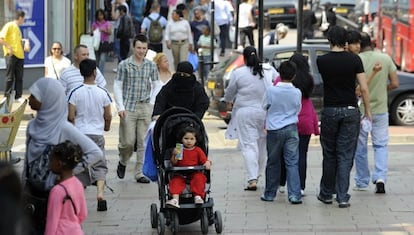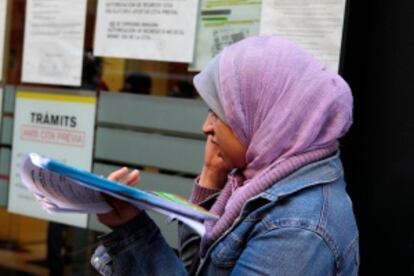Missing the big migratory picture
The movements of people who leave their homes to seek a new life are changing direction Europe’s closed-doors policy could be a big mistake

Spain is currently immersed in a debate over whether using razor wire on top of the fence that surrounds Ceuta — one of its exclaves in Morocco — is an acceptable way of “dissuading” would-be illegal immigrants; Greece is building a wall along its border with Turkey; Bulgaria is doing the same to keep out refugees fleeing the conflict in Syria … And while nations try different methods to protect themselves, little by little, the direction of migratory flows is shifting. The rich countries, mainly in the northern hemisphere, continue to be the priority destination for many people looking for a better life. But things are moving fast, and Asia is on the march.
“Europe, the United States and Canada will continue to receive immigrants, but many of them will also head for emerging economies,” says Demetrios Papademetriou, the president of the Washington-based Migration Policy Institute think tank: “The new destinations in these flows will be China, India and Turkey, but also countries such as Morocco, Mexico and Indonesia. You don’t need a crystal ball to see this. It’s already happening. In the West we’ve not fully grasped these changes. But in new host countries, such as Turkey, Brazil and Morocco, they are aware.”
It is clear that the governments of countries that have traditionally been the destination for migrants have not caught on, as is shown by the language used by our elected representatives: avalanche, waves and attacks are just a few of the terms often heard. Many of the measures that have been announced recently in Europe, Australia and North America are about imposing new limits, whether physical or legal. But a detailed look at the data of the last few years shows that migratory flows are changing. And they are changing very quickly.
Data from recent years shows that migratory flows are changing quickly
Flows from the southern hemisphere — from low- and middle-income countries toward the wealthier nations — are no longer the largest. Pablo Lattes, a researcher at the Population Division of the UN’s Economic and Social Affairs Department, explains: “If you add up the total over the last few decades, the most important route is still between Mexico and the United States. But if we look at more recent years, we see how Asia and Africa stand out. For example, if between 1990 and 2000 the increase in the number of foreigners was due by a third to arrivals to Europe and by two-thirds to North America; then between 2000 and 2010, a quarter was due to Europe, a quarter to North America, and almost 40 percent of displacements were to Asia. If we look back over the last three years, around 30 percent of migrants are heading to Europe, 18 percent to the United States, and 50 percent to Asia,” says Lattes. “Simplifying this, we can say that between 1990 and 2000, the growth in the number of foreigners was 100 percent in the north, and is now around 50 percent, while the rest of migratory flows are south-south. And we think that this trend is going to continue,” he adds.
Experts in migration warn that a rapidly aging Europe could face a demographic deficit by 2030 that will make maintaining its traditional welfare state — already hard hit by the ongoing depression — near impossible. The old world could need more immigrants exactly at the time when it has set its sights on holding back the other side of the planet. “If Europe continues with its restrictive policies, there is a very real risk that it will not be able to attract the qualified immigrants it needs in the current context of global competition,” says Catherine de Wenden, a French sociologist and head of the CNRS, the country’s science council. De Wenden, who has spent much of her time over the last two decades researching international migratory flows, is convinced that in the future there will be as many people heading north as moving in different directions within the southern hemisphere. “But the North will need to continue attracting more immigrants,” she says.
Demographic deficits could make the European welfare state near impossible
De Wenden accuses Europe and the United States of “failing to recognize that immigration is a factor in economic growth,” and that by putting obstacles in the way, it stands to lose out to other regions of the world in the longer term. She believes that politics is getting in the way of economics. “Everybody is talking about how to close borders, about how to keep immigrants out, when what Europe really needs are policies to facilitate the free movement of people. We have to extend the freedom of movement currently enjoyed by diplomats or senior business people to other categories, such as young people with no qualifications, giving them the possibility of working legally and avoiding falling into the hands of people traffickers.”
There seems little sign that Europe is about to change its immigration policies any time soon. There was much handwringing, along with calls for action, in the wake of the deaths of hundreds of migrants off the coast of the Italian island of Lampedusa in October of last year, but little has been done, and any discussion on changes to migration policy in the EU have been put off until after the European elections in June. In fact, the only real response has been to increase the number of military patrols along Europe’s Mediterranean fringes, coupled with plans to give a bigger role to Frontex, the EU agency was set up in 2004 with the job of overseeing the bloc’s borders.
“Europe is, and will continue to be, deeply confused about immigration, largely as a result of the political pressure applied by the far right, which sees the issue as an opportunity to increase its political support,” says Papademetriou of the Migration Policy Institute. “A decrease in the number of immigrants would be a loss for Europe, which has a declining birth rate, and will continue to do so. Immigration is inevitable, not on a massive scale, but we will continue to need them.”

Europe’s leaders have chosen to avoid raising the issue of new legislation until after the elections, knowing that right-wing parties stand to gain from the electorate’s concerns about immigration levels. In the United Kingdom, the ruling Conservative Party has made the issue a central policy plank. Most of the arguments are similar, and focus on the supposed economic burden that immigrants present to society. In a bid to attract support away from the anti-immigration and anti-EU UKIP party, Prime Minister David Cameron has taken the initiative, raising concerns about so-called health tourism, or the idea that hordes of Romanians and Bulgarians will, now that they are able to, flood into the UK in search of work and to take advantage of the country’s welfare state.
But academic research suggests that far from being a burden, migrants are net contributors to the welfare state. A study by University College London published in November shows that in the last 10 years, immigrants from the EU have contributed 30 billion euros in taxes to their host countries’ economies, paying 34 percent more than they received in terms of social services. A similar study by the National Institute of Economic and Social Research, which surveyed non-EU migrants and students living in the United Kingdom, concluded that foreign residents used social services less often than nationals, and that the relative balance between costs and benefits was positive both for the economy and public finances.
The OECD’s recent report on migration draws similar conclusions, saying that the impact on the economies of host countries is low. “Generally, it does not reach 0.5 percent of GDP, whether negatively or positively.” But the report notes that immigrants’ net fiscal situation tends to be less favorable than nationals, in large part because they pay lower taxes and social security quotas, and not because they are more dependent on social services.
What are the possible outcomes of more restrictive immigration policies? Joel Oudinet is from the North Paris Center for Economic Research, and is the co-author of a study carried out under the auspices of the EU on the challenges facing Europe between now and 2030. The work looks at different scenarios based on opening our countries up to migration to greater or lesser degrees. It concludes that the worst-case scenario for economic growth and the labor market within the EU’s member states is a closed-door policy, based on methods designed to keep migrants out.

“We are going to need proactive policies to feed immigration, as well as to think up multi-polar management solutions to migratory flows,” says Oudinet. “We have a real need for immigrants, though we will have to deal with problems related to integration and acceptance by host populations,” he adds. In his opinion, this process needs to begin by dismantling myths and fears that in large part are being fuelled by the ongoing crisis: “Such as migrants stealing jobs, which is not true. Migrants tend to work in certain sectors, such as manufacturing, cleaning and security.”
The experts agree that the problem is not a lack of solutions, but rather the fact that there is no political will to implement them. “There are many instruments that governments have at their disposal and can use, but it appears to be more and more difficult to use them in a rational way,” explains the president of the Migration Policy Institute. “And this is not just a European problem — it’s also happening in the US, where immigration reform has come to a standstill. It appears that it is more and more difficult to govern,” concludes Demetrios Papademetriou.
Support for those fleeing conflict
In 2009, the Mercosur nations (Uruguay, Paraguay, Brazil and Argentina), along with Bolivia and Chile, ratified a residency agreement facilitating free movement of their citizens. The agreement, to which Peru and Ecuador signed up in 2011, relaxed controls on earnings in a bid to tackle people-trafficking and labor exploitation. “Intraregional migratory flows within Mercosur are nothing new, but have intensified in recent decades. We have seen restrictive policies for many years, but the only thing they did was to increase the number of undocumented migrants,” says Marcela Cerrutti, of Argentina’s Center for Population Studies, who adds that the agreement has since impacted on national legislation.
“In 2004, in Argentina, the government changed immigration legislation, moving away from laws based on national security to a regulatory framework conceived in terms of respect for human rights,” says Cerrutti, adding that the Mercosur deal has helped migrants integrate into host societies, as well as keeping the host population informed about who is entering the country and what the government’s immigration policies are trying to achieve.
One of the myths associated with migration is that of the bogus asylum seeker. When migrants arrive in Europe, they are automatically registered as immigrants — in other words, people seeking work. But growing numbers of men and women arriving on the shores of southern Europe aboard rickety boats are fleeing political and religious persecution or conflict, particularly in the wake of the so-called Arab Spring.
But the reality is that overall, Europe has offered little or no support to people fleeing conflict on the southern side of the Mediterranean, and the burden of looking after those escaping from Syria has been borne by neighbors such as Jordan, Turkey and Lebanon. “The majority of refugees do not just come from the south, but, contrary to popular perceptions, they also live in regions close to where they have fled from,” reads the latest report by the International Organization for Migration. The United Nations High Commission for Refugees says that developing countries take four out of every five refugees, 80 percent of the total. The wealthy countries take less than 20 percent, while at the same time generating only one percent of refugees on a global scale. The likelihood, say both bodies, is that the South will be taking on a greater share in the future. “Another serious risk factor is the growth of forced emigration due to climate change, which in general will affect neighboring countries, most of which are in the South,” says Oudinet.
Safe passage
Faced with such a future, Catherine De Wenden believes that it will be necessary to establish some kind of global governance to deal with migration. And it won’t be easy, she adds: “On the one hand there is the United Nations, which is calling for emigration routes to be made safer and to guarantee migrants safe passage; while at the same time, nations are demanding more control over their borders.”
Pablo Lattes of the UN’s population division says that it would make more sense to establish regional accords, because the vast majority of displacements are produced between two or three countries. He points to the Mercosur initiative, and its open-door approach: “Those countries are making it easier to enter and leave, allowing migrants to return to their countries without problems; this will encourage people to return to their homes when they need to. Border controls make it more difficult: if people have to overcome significant obstacles to get in, they are less likely to want to repeat the experience to get out. Sweden has already begun to adopt a similar approach.”
Tu suscripción se está usando en otro dispositivo
¿Quieres añadir otro usuario a tu suscripción?
Si continúas leyendo en este dispositivo, no se podrá leer en el otro.
FlechaTu suscripción se está usando en otro dispositivo y solo puedes acceder a EL PAÍS desde un dispositivo a la vez.
Si quieres compartir tu cuenta, cambia tu suscripción a la modalidad Premium, así podrás añadir otro usuario. Cada uno accederá con su propia cuenta de email, lo que os permitirá personalizar vuestra experiencia en EL PAÍS.
¿Tienes una suscripción de empresa? Accede aquí para contratar más cuentas.
En el caso de no saber quién está usando tu cuenta, te recomendamos cambiar tu contraseña aquí.
Si decides continuar compartiendo tu cuenta, este mensaje se mostrará en tu dispositivo y en el de la otra persona que está usando tu cuenta de forma indefinida, afectando a tu experiencia de lectura. Puedes consultar aquí los términos y condiciones de la suscripción digital.
Archived In
Últimas noticias
Maduro pleads not guilty before the federal court in New York: ‘I am still the president of Venezuela’
A new test can detect Alzheimer’s from a finger prick
UN team enters Sudanese city of El Fasher after paramilitary massacre: ‘It’s like a ghost town’
A recipe for resistance: Indigenous peoples politicize their struggles from the kitchen
Most viewed
- Gilles Lipovetsky: ‘If you want to live better and fall in love, take Prozac, don’t look to philosophy’
- Alain Aspect, Nobel laureate in physics: ‘Einstein was so smart that he would have had to recognize quantum entanglement’
- Alvin Hellerstein, a 92-year-old judge appointed by Bill Clinton, to preside over Maduro’s trial in New York
- Maduro’s downfall puts China’s relationship with Venezuela to the test
- Why oil has been at the center of Venezuela-US conflicts for decades








































